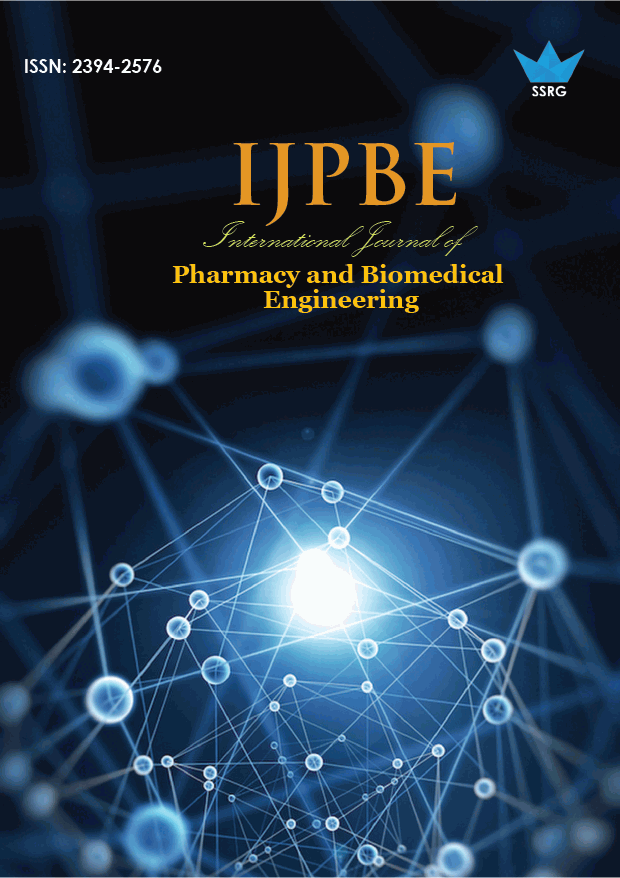Modelling Matured mRNA for Gene Expression Using Residue Number System

| International Journal of Pharmacy and Biomedical Engineering |
| © 2025 by SSRG - IJPBE Journal |
| Volume 12 Issue 1 |
| Year of Publication : 2025 |
| Authors : Joshua Apigagua Akanbasiam, Kwame Osei Boateng, Daniel Kuyoli Ngala |
How to Cite?
Joshua Apigagua Akanbasiam, Kwame Osei Boateng, Daniel Kuyoli Ngala, "Modelling Matured mRNA for Gene Expression Using Residue Number System," SSRG International Journal of Pharmacy and Biomedical Engineering, vol. 12, no. 1, pp. 1-7, 2025. Crossref, https://doi.org/10.14445/23942576/IJPBE-V12I1P101
Abstract:
The recent computing power and developments in Artificial Intelligence (AI) and machine learning have shifted research attention to the relevance of ascribing digital and computational ability to bioinformatics. Prior to developing into a mature messenger RNA (mRNA) that controls protein synthesis, the first ribonucleic acid (RNA) transcribed from a gene's deoxyribonucleic acid (DNA) template in most eukaryotes and some prokaryotic species must undergo processing. While processing mRNA, certain non-coding sections, introns, are excised, and the final, known as exons or coding regions, remain and are spliced to form mature mRNA. Number systems form the foundation for digital applications and there has been no known digital or computational model that has focused on RNS’ ability to model the matured messenger RNA train. The binary number system has served as the foundation for several digital and bioinformatics models. As there are only four (4) nitrogenous bases, applications based on a quaternary number system are desired for molecular biology. The excision of introns occurs at conserved sequences and the splicing of exons at exon junctions. The conserved sequences are modelled as sequences of RNS digits. In the lariat formation, the conserved sequence links up with a branch point to form a stop codon at the neck of the lariat. During splicing, the exon junctions of the preceding exons are spliced with the start base of the succeeding exon, and these are modelled as di-bases. This enables an easy and simple RNS modelling of intron excision and exon splicing processes. This technique is well-structured algorithmically within the RNS space, reinforcing experts' claim for a quaternary number system for molecular biological applications.
Keywords:
Conserved sequences, Exons, Intron, Residue number system, Splicing.
References:
[1] Sávio Torres de Farias, and Francisco Prosdocimi, “RNP-World: The Ultimate Essence of Life is a Ribonucleoprotein Process,” Genetics and Molecular Biology, vol. 45, no. 3, pp. 1-10, 2022.
[CrossRef] [Google Scholar] [Publisher Link]
[2] Amanda S. Solis, Nikki Shariat, and James G. Patton, “Splicing Fidelity, Enhancers, and Disease,” Frontiers in Bioscience, pp. 1926 1942, 2008.
[CrossRef] [Google Scholar] [Publisher Link]
[3] RNA Splicing - Wikipedia, 2023. [Online]. Available: https://en.wikipedia.org/wiki/RNA_splicing
[4] Donny D. Licatalosi, “Intron Removal by the Spliceosome: A Solo Job or a Team Effort?,” Molecular Cell, vol. 81, no. 11, pp. 2275 2277, 2021.
[CrossRef] [Google Scholar] [Publisher Link]
[5] Bong-Seok Jo, and Sun Shim Choi, “Introns: The Functional Benefits of Introns in Genomes,” Genomics Informatics, vol. 13, no. 4, pp. 112-118, 2015.
[CrossRef] [Google Scholar] [Publisher Link]
[6] Harvey L. Garner, “The Residue Number System,” Proceedings of the Western Joint Computer Conference, San Francisco, California, pp. 146-153, 1959.
[CrossRef] [Google Scholar] [Publisher Link]
[7] Amos R. Omondi, and A. Benjamin Premkumar, Residue Number System Theory and Implementation, World Scientific Publishing Company, pp. 1-312, 2007.
[Google Scholar] [Publisher Link]
[8] Hassan Kehinde Bello, and Kazeem Alagbe Gbolagade, “Acceleration of Biological Sequence Alignment Using Residue Number System,” Asian Journal of Research in Computer Science, vol. 1, no. 2, pp. 1-10, 2018.
[CrossRef] [Google Scholar] [Publisher Link]
[9] Applied Biosystems SOLiDTM 3 System Instrument Operation Guide, Applied Biosystems, pp. 1-8, 2016. [Online]. Available: https://assets.thermofisher.com/TFS-Assets/LSG/manuals/4407430b.pdf
[10] Tech Summary: ABI’s SOLiD (Seq. by Oligo Ligation/Detection), UPDATED for v2.0 – SEQanswers, 2021. [Online]. Available: http://seqanswers.com/forums/showthread.php?t=10
[11] ABI Solid Sequencing - Wikipedia, 2021. [Online]. Available: https://en.wikipedia.org/wiki/ABI_Solid_Sequencing
[12] Pavla Hujová et al., “Nucleotides in Both Donor and Acceptor Splice Sites are Responsible for Choice in NAGNAG Tandem Splice Sites,” Cellular and Molecular Life Sciences, vol. 78, no. 21-22, pp. 6979-6993, 2021.
[CrossRef] [Google Scholar] [Publisher Link]

 10.14445/23942576/IJPBE-V12I1P101
10.14445/23942576/IJPBE-V12I1P101